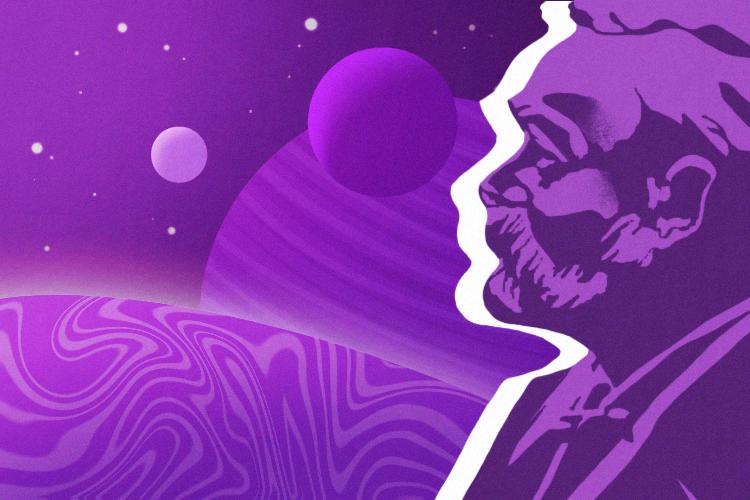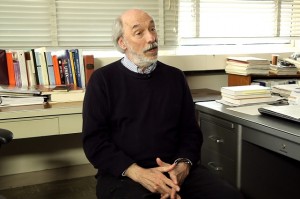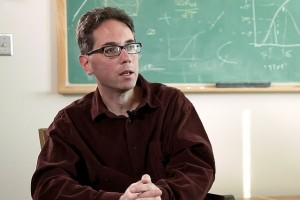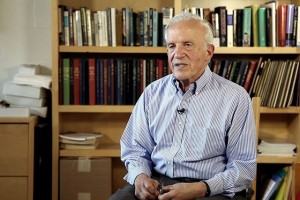Electron – Positron Annihilation
Physicist Frank Taylor on quarks, muons, and the Standard Model

The Big Bang cosmological model describes the evolution of the Universe starting from the very beginning, from a tiny fraction of a second after an initial state that we don’t fully understand yet. This state can be called ‘the beginning’, or some state in which the physical laws to which we are used now do not apply. But after that initial state, we can more or less describe what happened to matter, radiation, and the other components of the Universe during its expansion.
Georges Lemaître, the first scientist to speak about the “expansion” of the Universe, also developed a model of the beginning of the Universe called the Primeval Atom. Trying to put together quantum mechanics and relativity (a yet unsolved problem) when looking at the evolution of the Universe back through time, he conceived the idea that at the very beginning of the Universe, there should have been a giant nucleus. Since we don’t observe nuclei with an atomic number greater than 200, this was an unstable state which exploded and generated the Universe.
Lemaître’s colleagues were strongly against this idea, essentially for philosophical reasons concerning the notion of “creation” (Lemaître was a Belgian Catholic priest). Sir Arthur Eddington, who had been Lemaître’s teacher at Cambridge University, published a paper in Nature stating that the very idea was repugnant to him. Interestingly, Fred Hoyle, the founder of the steady-state model of the Universe, coined the name ‘The Big Bang’ during a BBC transmission as a joke on Lemaître. And then the name remained.
Einstein, too did not approve of this idea. The new science “cosmology” was introduced by Einstein in 1917 based on the idea of a “static” universe; he shared the views of Spinoza’s philosophy that rejects the idea of the beginning of the Universe. But Lemaître, who was also a theologist and a philosopher, made a point that there was a total distinction between “creation” and “beginning of the Universe” because even an eternal Universe could have been created.
On the other side, Pope Pius XII was eager to use the new scientific understanding to support the idea of creation. At the time, Lemaître was the president of the Pontifical Academy of Sciences (one of the most prestigious academies of science in the world) and recommended that the Pope did not make this confusion and completely avoided the usage of the Big Bang model in theological arguments.
To summarize, there were many objections to the idea from a philosophical point of view. Curiously, this is precisely contrary to the status of Ptolemy’s model of the Universe from the Greek civilization till the Copernican revolution. That model was also intended to establish ethics and the right human behavior.
After the discovery of the cosmic microwave background, no one believed in the steady state of the Universe anymore. The idea that the Universe was expanding was already accepted in the 1930s after the observation of the Redshift of the galaxies by Hubble. But if the Universe expands, Lemaître claimed, going backward in time, we should meet its initial state. A scientific objection to this idea was that this might be true just for a truly homogeneous universe, but if there is some inhomogeneity, then the initial singularity may be escaped. But in the 1960s and 1970s, Hawking and Penrose proved a theorem that stated that the initial singularity is always inescapable.
The modern scientific understanding of the Cosmos has been built in the last one hundred years, but there still is intrinsic instability: our present understanding may change at any moment because of a new, unexpected observation. Such a sudden change happened in 1997 with the observation of Type Ia Supernovae. Nowadays, however, we entered the era of precision cosmology, and the risk of another sudden radical change is lower.
Astrophysicists and cosmologists are more or less convinced that dark matter exists even though they cannot see it in laboratories. Dark matter manifests itself through its gravitational effects. There are several scales where it shows up: it is there at the level of galaxies to make them rotate the way they do, and, at a larger scale, dark matter is also necessary for the process of structure formation in the Universe.
In summary, today, we think that the Universe is composed of dark energy, dark matter plus baryons, leptons, and radiation. To describe the evolution of the Universe, we use General Relativity, but we have to appeal to things that we don’t see, although the possibility exists that we are wrong and might have to deal with General Relativity for another theory of gravity one day.
The idea behind the Big Bang theory is that the Universe is neither static nor eternal, as both Einstein and Ptolemy imagined. In the old Ptolemaic cosmological model and even in the new model of Copernicus, the Universe was divided into two parts: the sub-lunar part, corruptible and imperfect, where changes were taking place, and the supra-lunar part – perfect, circular, and without changes. Einstein held on to the idea that the Universe is static. But towards the end of the 1920s, that idea was shattered and set aside: the Universe is not static at all but is expanding. This expansion doesn’t mean simply that the objects move in the Universe, but it means that the Universe itself expands like a balloon that inflates: the objects become more and more distant from each other because of the expansion, like dots on a balloon. If the Universe were to contract, it would have become hotter and hotter until it would have reached a state with a density and a temperature so high that we wouldn’t be able to use the physical laws as we understand them now. And this is the initial state that we call the Big Bang. It is commonly said that this initial state could be described with the help of a quantum theory of gravitation. But such a theory doesn’t exist yet: at the moment, we are unable to marry general relativity and quantum mechanics into a coherent, unified theory.
After that initial moment, when all the forces were unified into one, there were different stages of “symmetry breaking”: the strong force separated from the electroweak force, then the electroweak force separated into the weak and the electromagnetic forces. There are different mechanisms that all try to reproduce this part of the history of the Universe, a tiny fraction of a second, which is essential for the understanding of the Universe. Every day we discover a larger portion of the Universe because the velocity of light is finite; we believe that the Universe is around 14 billion years old, and the light that we perceive comes from 93 billion light-years.
The Universe was radiation-dominated for the first 50 000 years. The components of the Universe evolve at different rates because radiation dilutes faster than matter. Light (radiation) dilutes with the inverse fourth power of the radius of the Universe, while matter dilutes with the inverse third power of the radius of the Universe (while the Universe expands the inverse radius to the fourth power, becomes smaller and smaller than the inverse radius to the third power). Radiation gets more diluted, and matter takes over, and this changes the speed of expansion of the Universe: in a sense, the matter content of the Universe opposes itself to the expansion.
We believe that the Universe was matter-dominated for 10 billion years, and its expansion was slowing down during that time. The idea was that the expansion would continue slowing down until it would stop after an infinite time; the spatial geometry of the Universe (as opposed to its spacetime geometry) is believed to be spatially flat. We still believe that the spatial geometry is flat, but at a certain point, the Universe started accelerating, so now the expansion is no more slowing down but going faster and faster. This has been so for the last 4 to 5 billion years.
This acceleration is caused by another important component which acts like anti-gravity. As gravity attracts objects to each other, there must be something that pushes them apart, and this is called dark energy, the largest component, 70% of the energy content of the Universe. This Big Bang model is therefore named after the major components of the Universe ΛCDM (Lambda-Cold Dark Matter). The dark energy component is most easily and effectively represented by the cosmological constant Λ. Although dark matter is the largest part of matter, we can’t see it; only 5% of the Universe is visible matter.
We may have an intuition of what symmetry breaking is by thinking about something we are accustomed to in everyday life. We all know that water behaves in a certain way above a certain temperature, while below a different temperature, water starts behaving in a totally different way. Liquid water even looks completely different from ice or steam: these are three different states (or phases) of this unique substance, a prototype example of how substances behave in completely different ways when the temperature changes. These phenomena are called phase transitions, and they are, in turn, explained by the breaking of some symmetry. This idea also applies to the behavior of the Universe in its very early life; when the temperature was extremely high, the different kinds of interactions between particles were unified into one.
What are these interactions? The strong force is the force that ties together the quarks in nuclei. For instance, a proton is not an elementary particle; it’s made of three quarks. We can’t see them separately; they are confined to the proton. But if the temperature is very, very high, the links in the proton get broken, giving rise to the quark-gluon plasma (the gluon is the particle mediating the strong interaction). The weak force is responsible for the Sun burning instead of exploding, and the electromagnetic force is the basis of our everyday life. At a very high temperature, all these forces are unified together. But as the temperature decreases, the strong force separates from the electroweak one, and then the electroweak force breaks into the weak and the electromagnetic forces.
The electroweak theory accounts for the weak and electromagnetic interactions in a unified way. Weinberg, Glashow, and Salam proposed it between the 1960s and the 1970s. Carlo Rubbia and his team detected the vector bosons W and Z mediating the weak interaction in 1983. Still, the unification of the strong force with the electroweak force is not completely understood. Whether the two theories are joined into one or not also depends on Supersymmetry.
The new ingredient that was added to the scheme in the 1980s was the so-called inflation. This is a phase in which the Universe, at the very early beginning, around 10-33 seconds after the Big Bang, begins its rapid exponential expansion. This expansion, in particular, explains the observed homogeneity and isotropy of the Universe. Homogeneity means that the Universe is homogeneous in space: imagine to foliate the Universe into slices of constant cosmic time and look at the spatial slices: on a very large scale, at a scale larger than clusters of galaxies, all locations are equivalent; there are no differences in different parts of the Universe, it is all the same — and that is the homogeneity problem of the Universe. There is also no privileged direction (isotropy): up and down don’t exist in the Universe. All directions are equivalent; all points are equivalent to each other on a very large scale. The exponential expansion, which lasted for a tiny fraction of a second, may explain why. In a tiny fraction of a second, a millimeter expanded to 10 light-years.
Before cooling down, the Universe was too hot for atoms to exist. The atom is made of a nucleus charged positively and an electron charged negatively, but if the temperature is high enough, positively charged nuclei and negatively charged electrons are separated, and the atom cannot form. When the temperature went down and reached 4000 Kelvin, hydrogen atoms could form. This epoch is called the Recombination epoch and lasted for a few thousand years, starting when the Universe was 377 000 years old.
So the Universe became transparent, and we now perceive the released radiation at that time. Apart from the recombination and decoupling of the photons, there is no other explanation for why we receive the same photons from all the parts of the Universe.
At that time, the color of the Universe was orange. There were no stars, but there was light. With the expansion of the Universe became redder because the wavelength of light expands as well. So light became redder and redder until it disappeared into the invisible radio spectrum. The Universe entered the so-called Dark Age. It was completely dark for millions of years until the first star was born. Matter slowed down the expansion of the Universe; the little inhomogeneities due to quantum fluctuations started forming clumps. Filaments of dark matter gravitationally attracted the normal matter forming disks that gave birth to the first stars, the stars of the first generation; they were made of hydrogen and helium.
At the time, there was nothing else but hydrogen, helium, and lithium in the Universe. The stars of the first population lived for a very short time because they were very big: 300 times bigger than the Sun. A star has a life: it is born, it lights on, and then it turns out its fuel. There are several transitions in the star. In the end, they can’t balance the gravity with the pressure in the core, and the thermal equilibrium can’t be supported anymore. The star can’t sustain itself and explodes. In this explosion, new heavier elements are created, the ones which everything on Earth is made of.
The cosmic microwave background is more or less a smoking gun evidence of the Big Bang. It is proof that the Universe was in a hot phase and then started to expand and acquire the shape in which we see it today after billions of years. Cosmic microwave radiation was accidentally discovered in 1964 by Penzias and Wilson; they won the Nobel Prize for this discovery.
Cosmic microwave radiation is a microwave that we see appearing from all directions of the sky: from the whole celestial sphere, we receive photons, all of which are of the same temperature (2.7 Kelvin). The question is: how is it possible that a messenger that comes from one side of the Universe and another messenger coming from the opposite side of the Universe both carry the same message, i.e., the same temperature? They could not have been in contact with each other.
In the last experiment, the Planck satellite took a very precise picture of cosmic microwave radiation, the temperature, and the fluctuation of the temperature. Those fluctuations in the temperature are the quantum seeds that then form galaxies.
The recent observation of gravitational waves in the last three years opened a new chapter in astronomy. At about 377 000 years, the universe became transparent, but we cannot see the light coming from the universe before that time. But we can, in principle, see the gravitational waves that were emitted before. This opens a window to directly observe the Big Bang.
Two years ago, there was an announcement that an American team had found the primordial gravitational waves emitted at the very beginning, but that turned out to be something different. In order to see the primordial gravitational waves, we will have to wait for 10 or 15 years until the LISA space mission is launched. The LISA space mission is going to have a constellation of three satellites arranged in an equilateral triangle, with each side 2.5 million km long. The satellites will be flying along an Earth-like orbit. LISA will be able to see the primordial gravitational waves, and it will be a way to see much back in time. The technology we have now is not apt to observe primordial gravitational waves, so we will find out more about them starting in 2030.
Edited by Karina Akopyan

Physicist Frank Taylor on quarks, muons, and the Standard Model

Astrophysicist Joshua Winn on giant planets formation, the puzzle of their sizes, and discovery of exoplanets

Physicist Daniel Kleppner on Bose-Einstein condensation, atom beams, and quantum computers